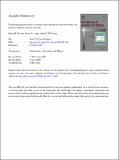Files in this item
Disambiguating past events: accurate source memory for time and context depends on different retrieval processes
Item metadata
| dc.contributor.author | Persson, Bjorn Martin | |
| dc.contributor.author | Ainge, James Alexander | |
| dc.contributor.author | O'Connor, Akira Robert | |
| dc.date.accessioned | 2017-05-09T23:33:45Z | |
| dc.date.available | 2017-05-09T23:33:45Z | |
| dc.date.issued | 2016-07 | |
| dc.identifier | 242456350 | |
| dc.identifier | d77f6544-644f-4b66-905f-1a4d9b753aa0 | |
| dc.identifier | 84977674595 | |
| dc.identifier | 000378011700005 | |
| dc.identifier.citation | Persson , B M , Ainge , J A & O'Connor , A R 2016 , ' Disambiguating past events: accurate source memory for time and context depends on different retrieval processes ' , Neurobiology of Learning and Memory , vol. 132 , pp. 40-48 . https://doi.org/10.1016/j.nlm.2016.05.002 | en |
| dc.identifier.issn | 1074-7427 | |
| dc.identifier.other | ORCID: /0000-0002-7943-5183/work/34028960 | |
| dc.identifier.other | ORCID: /0000-0002-0007-1533/work/60428114 | |
| dc.identifier.uri | https://hdl.handle.net/10023/10735 | |
| dc.description | Participant payment was provided by the School of Psychology and Neuroscience ResPay scheme. | en |
| dc.description.abstract | Current animal models of episodic memory are usually based on demonstrating integrated memory for what happened, where it happened, and when an event took place. These models aim to capture the testable features of the definition of human episodic memory which stresses the temporal component of the memory as a unique piece of source information that allows us to disambiguate one memory from another. Recently though, it has been suggested that a more accurate model of human episodic memory would include contextual rather than temporal source information, as humans’ memory for time is relatively poor. Here, two experiments were carried out investigating human memory for temporal and contextual source information, along with the underlying dual process retrieval processes, using an immersive virtual environment paired with a ‘Remember-Know’ memory task. Experiment 1 (n = 28) showed that contextual information could only be retrieved accurately using recollection, while temporal information could be retrieved using either recollection or familiarity. Experiment 2 (n = 24), which used a more difficult task, resulting in reduced item recognition rates and therefore less potential for contamination by ceiling effects, replicated the pattern of results from Experiment 1. Dual process theory predicts that it should only be possible to retrieve source context from an event using recollection, and our results are consistent with this prediction. That temporal information can be retrieved using familiarity alone suggests that it may be incorrect to view temporal context as analogous to other typically used source contexts. This latter finding supports the alternative proposal that time since presentation may simply be reflected in the strength of memory trace at retrieval – a measure ideally suited to trace strength interrogation using familiarity, as is typically conceptualised within the dual process framework. | |
| dc.format.extent | 9 | |
| dc.format.extent | 1262386 | |
| dc.language.iso | eng | |
| dc.relation.ispartof | Neurobiology of Learning and Memory | en |
| dc.subject | Episodic memory | en |
| dc.subject | Time | en |
| dc.subject | Context | en |
| dc.subject | Recollection | en |
| dc.subject | Familiarity | en |
| dc.subject | BF Psychology | en |
| dc.subject | RC0321 Neuroscience. Biological psychiatry. Neuropsychiatry | en |
| dc.subject | NDAS | en |
| dc.subject.lcc | BF | en |
| dc.subject.lcc | RC0321 | en |
| dc.title | Disambiguating past events: accurate source memory for time and context depends on different retrieval processes | en |
| dc.type | Journal article | en |
| dc.contributor.institution | University of St Andrews. School of Psychology and Neuroscience | en |
| dc.identifier.doi | https://doi.org/10.1016/j.nlm.2016.05.002 | |
| dc.description.status | Peer reviewed | en |
| dc.date.embargoedUntil | 2017-05-09 |
This item appears in the following Collection(s)
Items in the St Andrews Research Repository are protected by copyright, with all rights reserved, unless otherwise indicated.

